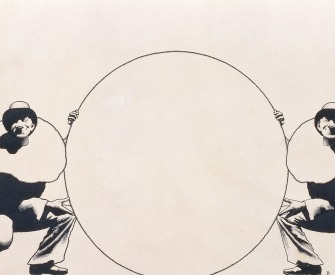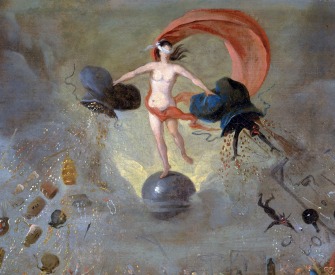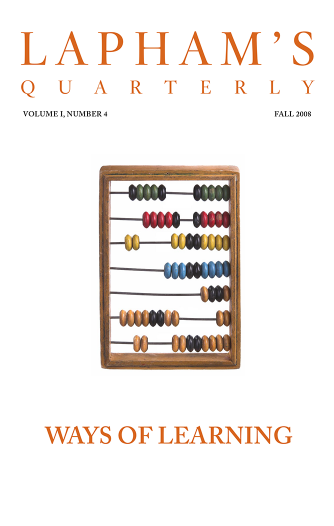No human being is innocent, but there is a class of innocent human actions called games.
—W.H. Auden, 1962Blossom and Fade
Hermann Hesse’s The Glass Bead Game is an experience with the pathos and wonder of all games—the game that is the universe.
By John Crowley
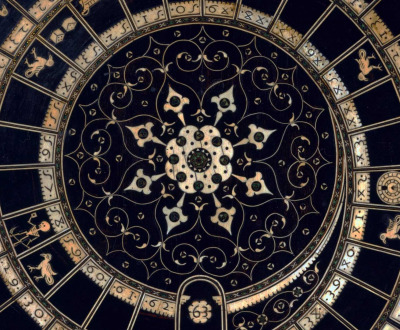
Chess and goose game board, sixteenth century. The Metropolitan Museum of Art, Pfeiffer Fund, 1962.
In 1943 Hermann Hesse published his last major work, Das Glasperlenspiel (The Glass Bead Game). It was first published in English in 1949 under the title Magister Ludi, which is the novel’s Latin designation for the chief controller and premier player of a complex and esoteric intellectual endeavor, the Glass Bead Game, which a dedicated monastic cult will have perfected in a peaceful and rational world about three hundred years from now. The book was important to Hesse’s winning the Nobel Prize for Literature in 1946, maybe because it was so long (892 pages in the original German edition). Hesse began writing it in 1931, and it asks to be read in the context of its time, though it has no overt connection to politics—in that respect resembling James Hilton’s Lost Horizon, 1933, also a vision of peace, possibility, and virtue somewhere else than here and now.
It’s not easy to imagine what reading it must have been like for German speakers in 1943 (Hesse’s books were banned by the Nazis by then). I read it, like many people my age, when a new translation (restoring the original title) appeared in 1969—a different sort of year, not three hundred years on, though sometimes it seemed to be: like living in the future, or far away. We’d already read the hallucinatory Steppenwolf and the mild Siddhartha; the theosophy and Jungian esotericism Hesse had grown up with were coming back hotly, the onset of new-old possibilities that somehow yoked renunciatory asceticism with personal liberation and indulgence, mild peaceableness with violent rejection of the status quo and its masters. It may seem strange that so many could have read this often tedious and peculiarly arid book, but they did—or at least enough of it to get the idea, the gist, of an all-encompassing, all-absorbing game that can be played but never finished, mastered but never won.
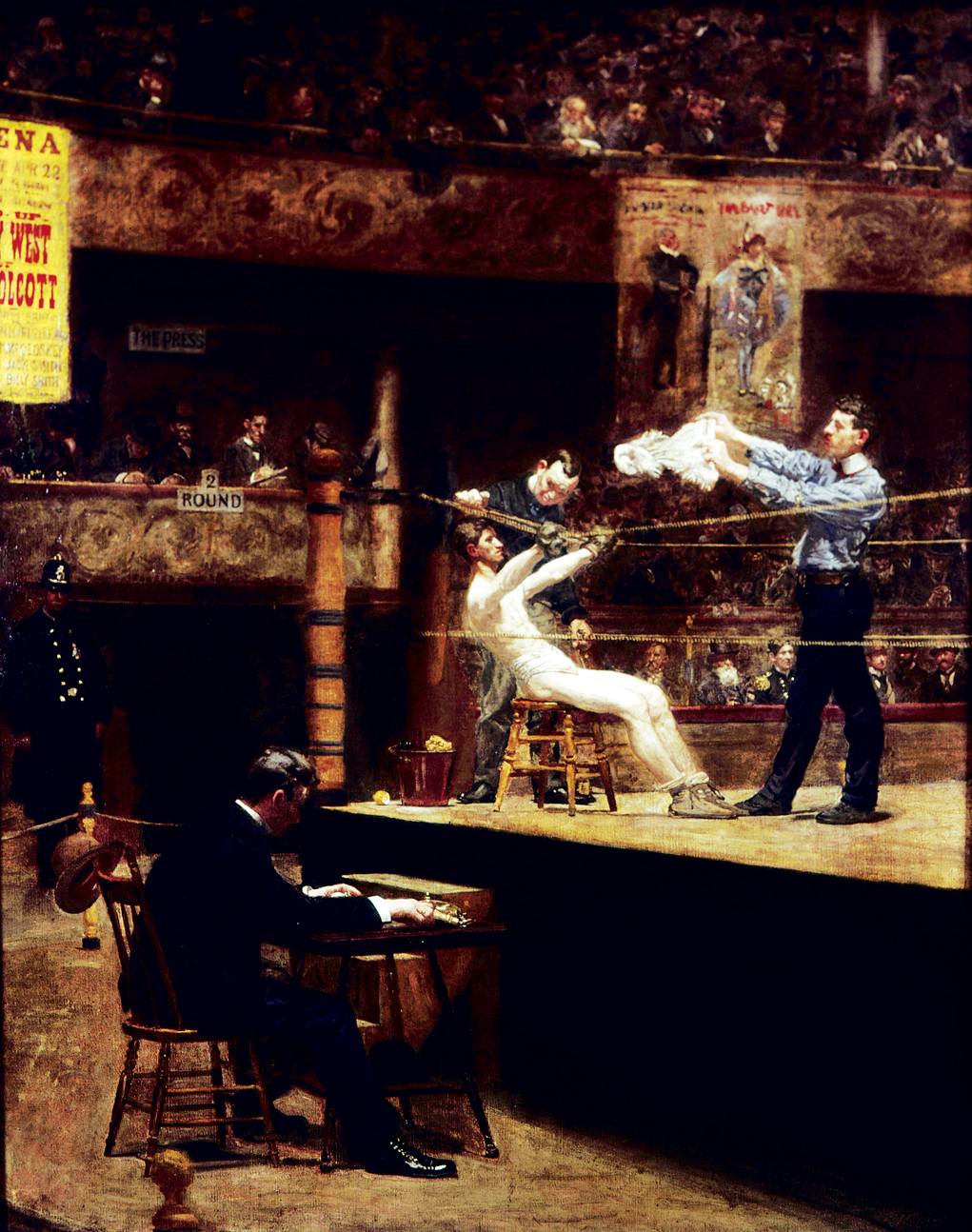
Between Rounds, by Thomas Eakins, c. 1899. Philadelphia Museum of Art, Philadelphia, Pennsylvania.
It evolves, or will evolve, in this way. In the Age of the Feuilleton—a period that seems to encompass both Hesse’s time and our own—though people have acquired “an incredible degree of intellectual freedom,” culture has degenerated into a mess of pandering to mass taste, superficiality, showing off, and a lack of rigor such that the very notion of “rigor” has vanished; truth is diluted to opinion and maundering, art is deprived of connection to profound practices of the past, writing and education deal with ephemera. This time of confusion and excess leads to, or is at any rate followed by, the Century of Wars, after which, through the dedication and labor of a few remarkable individuals, discipline and order are returned to intellectual pursuits. Formal mathematics and classical music from Michael Praetorius to Mozart are rediscovered. And while creativity and originality in art and other intellectual pursuits never recover from the bad ages, a new power begins to emanate from reviving intellectual centers, as from the monasteries of the ages formerly known as Dark. A strictly regulated brotherhood upholds scholarly standards of such purity that they gradually win admiration for standards in themselves. Teachers trained in the new institutions, called Castalia collectively, go out to instill a new elite with enduring values, and while the common pursuits of mankind—marrying, making money, politics—continue, at least they are pursued rationally and temperately.
(This sort of elaborated summary is actually the mode of the book, which is one long violation of the creative-writing teacher’s “show don’t tell” rule.)
Anyway, in the isolation of Castalia, a new art or science will be perfected. It will arise first in the music academies, where a system of glass beads of different sizes and colors, strung on a frame like an abacus, is used to represent musical themes and the rules of counterpoint, allowing themes to be reversed, transposed, and developed. Problems and challenges in music theory can be set and solved with the game in interesting ways. Soon other disciplines, philology, physics, begin to see ways to employ and expand the symbol sets. “Mathematicians in particular played it with a formal strictness at once athletic and aesthetic.” (“Strict” and “strictness” are ubiquitous words in the book.) From Chinese beliefs that music can model the structure of heaven and earth—and from the expressive possibilities inherent in Chinese ideograms—come further developments, until it will be possible for players of the evolved game to deploy a language of symbols (the glass beads themselves long since given up) to unveil the real relations among far-flung products of intellectual endeavor: perhaps a first theme of a Scarlatti sonata evoking an equation mentioned in an Arab manuscript, answered by an oddity of Latin grammar in one direction, a fragment of Parmenides, or a rule in Vitruvian architecture in another. When players begin to practice meditation techniques, games will become at once more personally expressive and more universal. Top players will introduce new symbol sets—alchemical emblems, the I-Ching; in weeks-long festivals their games induce in observers ineffable experiences of insight.
Wow. However all this was understood in 1943, when I came upon it, the idea that a single reality underlies music and mathematics, art and science, expressible only in a nonverbal language of very cool hieroglyphs, was irresistible, attracting the serious psychedelic vanguard and the daily dope smokers alike. It was easy to feel that our late-night speculations in aromatic Hoboken lofts or Topanga cottages were games of the same kind, and we were players (though doubtless we more closely resembled the vain and fatuous spielers of the Feuilletonist Age). But we were drawn also by a game “played” more as music is played than as a sport is played, a game that players spend a lifetime learning and yearning to excel in, but in which they can excel only by cooperating, not competing: you triumph at the Glass Bead Game only insofar as other players do too. No one is defeated. That’s what got to me, and what I talked about with others, when I first read the book.
I have recently reread it, though, thinking anew about games, sport, and competition, and apparently I was wrong about that aspect of the Game. It seems (though the artfulness of the book lies in how little is made definite about it) that at the highest level the Game is played by a single performer, like a raga, and not with or against others at all.
Of course the precise events of long novels tend to slip away like the events in dreams as soon as the book is closed, leaving only general impressions of a situation and an emotional landscape, and are often misremembered afterward. But I was hardly the only one who understood the Glass Bead Game in the way that I then did. We had our reasons. And I had reasons of my own as well.
I grew up sportless.
This wasn’t deprivation; it was all my own disposition, or fate. My father was a lover of sports, a golfer; he’d played baseball and basketball in the 1920s at his high school. It might have been important that I had no older brother (no younger, either—only sisters.) I was a kid in a regular Catholic grammar school in Vermont, where doubtless sports were played, though I remember nothing of them. When I was nine or ten I was sent away to a boys’ camp in the White Mountains, where, suddenly sequestered among boys and games, I realized what a loss I was at. I hardly knew the rules of baseball, much less the art of it, or the right catcalls, stances, attitudes to take. I am probably lucky to have survived, though a measure of my exclusion from the world of boy games is how little I felt the contempt and rejection of the other lads (and the counselors too, no doubt.) I really didn’t notice what boys thought of me. Girls were different. My hero was Georgie Porgie, who kissed the girls and made them cry: when the boys came out to play, I ran away.
I was conscious that I was a disappointment to my father, or perhaps “conscious” is the wrong word. When I was in the seventh grade, a Little League recruiter came to my school, and I was able that evening to tell my father I had signed up to play. The next day, he came home from work with a bat, a ball, and a glove for me: very high quality, too, even I could tell that. Unlike the dads in the grade-school readers, mine didn’t come home with presents on random weekdays; they were dispensed only at designated feasts. This was truly exceptional. I went to a few practices, opting to play right field (I was aware nothing much happens in right field, and with luck I would have few opportunities for a display of ineptitude). Then I quit. Years later, in a rare intimate conversation, my father hearkened back to that moment; he had been so careful, he said, not to push me into playing sports against my will; it had gladdened him when I’d chosen to play all on my own. By then I knew, of course, why I’d signed up.
At that time, and for long after, I assumed that I was simply physically unfit for sports. I was short, skinny, absentminded. But that’s not it. I was then and am now at least as physically coordinated as most of my peers; I didn’t throw like a girl, or trip over my feet. If I could have taken up a sport that none of my contemporaries played, which therefore didn’t have an established culture to be excluded from—soccer, say, or squash—I might have done well. No, I have come to understand that the lack lay not in my physical attributes or even my nerdy self-exclusion but in an inherent problem with competition. My fight-or-flight meter has simply always been set a few clicks more than normal over toward flight.
That’s not to say I haven’t been proud of doing well, at all kinds of enterprises, or glad to have done better than others. As a freshman, I was chosen for a spot on my university’s team competing on the Sputnik-era TV quiz show College Bowl, and we won, largely due to my own answers—a display of wide-ranging useless knowledge and a gift of instant recall that I’m still (obviously) rather pumped about. But I can’t remember feeling that I, or we, were up against another team, toe to toe. It was just a game, and not a zero-sum one; our score mounting up took nothing from them. In the end our pile was higher. It felt entirely different from, say, being challenged to fight, as I was once or twice, when I had no thought but evasion.
When later on I came to invent futures of my own—thinking up stories that would be labeled science fiction—I, like Hesse, could create a centuries-from-now world in which competition is not the engine, neither for survival nor for fun. It became clear, though, as my own actual century moved on that, whatever the transcendental cadre hoped or worked toward, whatever the far future might hold, the hot current of competitiveness wasn’t going to burn out: certainly couldn’t, probably shouldn’t, in spite of everything. It runs even deeper, and in certain ways much darker, than I supposed in the days when I used my wiles to escape it. A woman I was working with on a film was one day making comic hay about men and their testosterone and their mano a mano, and I said, It’s not funny: do you think we like being stuck in this fix? Enslaved to combat, like gladiators, unable to end it? It’s tragic, and the font of tragedies.
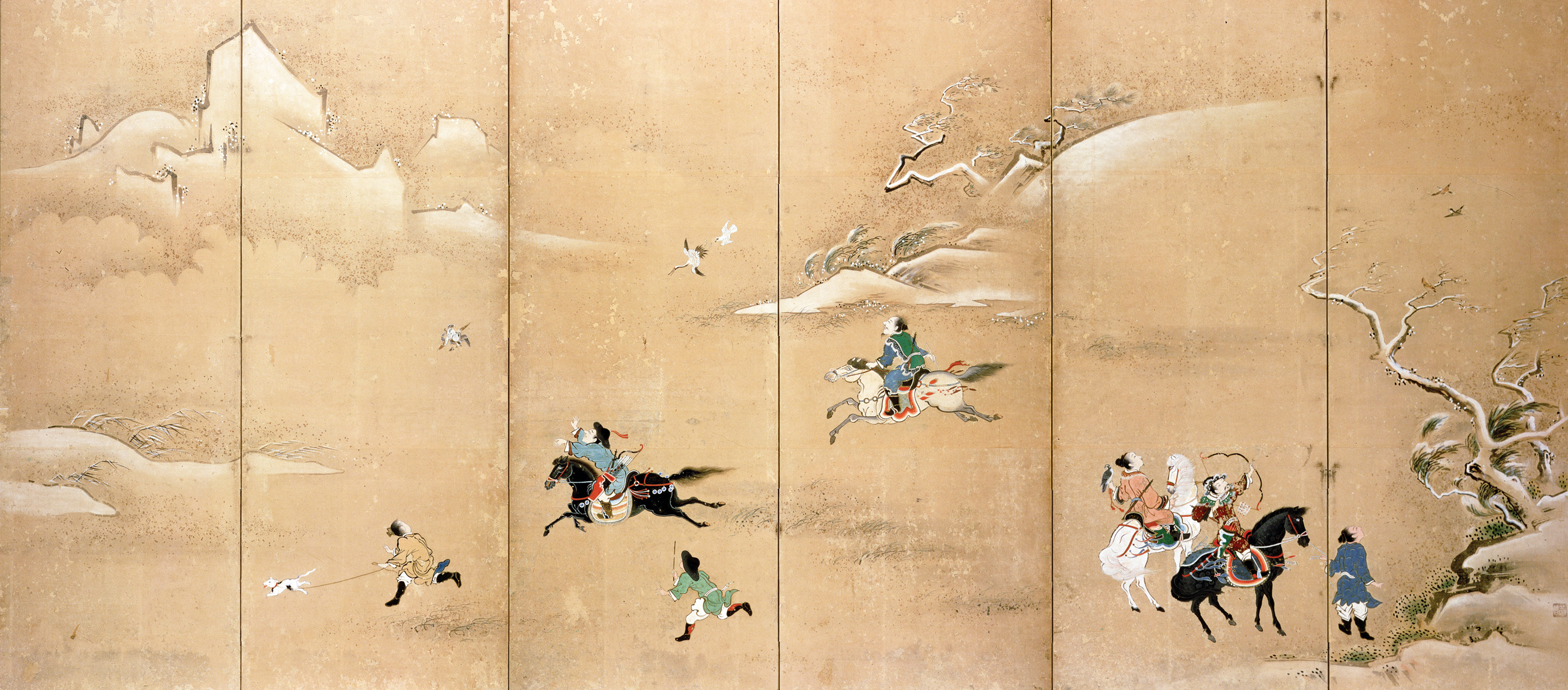
Boar hunt, Japanese folding screen, c. 1800. © Christie’s Images, The Bridgeman Art Library International.
This is to talk as though women do not and will not have a drive to compete, which is inadequate, of course, to the recent outing of female competitiveness in every realm of life, including sports, including the male-bonding hunter-group team sports (I live not far from the University of Connecticut, where one of the greatest dynasties of college sport has been playing basketball for years). Yes, and my own daughters have competed, too, from early ages, in sports galore, one in junior paralympic swimming (still holds a record), and the other in softball, basketball, cross-country running, and Ultimate Frisbee, the world’s best new team sport. Early on I had to explain to them that though I could show many admirable qualities as a dad, I’d be no help to them there, had no guidance and no tricks to impart; I hoped they’d find wise, tough coaches. I cheered my heart out at their contests, astonished at my fifth-grade daughter’s cool concentration at the free-throw line, glad and proud when her team beat theirs, though secretly wishing that somehow they both could win.
So male sports, in which males triumph over other males, whether joined in teams or each against all (golf, auto racing), aren’t singular, but certainly the attention paid to them is. Margaret Mead once suggested that a recurrent problem for civilization was finding something satisfying for the men to do, and in our place and time, what has largely been found for them to do is to play sports. Or rather to associate themselves with the playing of sports—which is to say experiencing the joys of competition, loyalty, and triumph, as well as the agony and shame of defeat, without actually moving any physical part of themselves except the arm in the air.
This intense and pervasive spectatorship has been described as a kind of decadence, one more example of the exhaustion of our culture and the conquest of the real by the manufactured, the immediate by the reproduced. If sport is virtual war, virtual conquest, we have moved now into a world of virtual sport, where we are served up near-impossible displays of skill, force, will, and invention performed by competitors living in a realm beyond the ken of all but themselves. We track and replay their moves and analyze reams of statistics to compare their performances with past ones; we can play the same sports in digital form, creating new games, peopled by eidolons of real athletes, or similar but wholly invented ones. Fantasy-football and -baseball leagues, in the predigital age employing cards or other symbol sets to represent players and game events, now exfoliate on the Internet into virtually infinite possibilities. Professional competitors apparently like playing video games based on their sports, featuring avatars of themselves in realistic action.
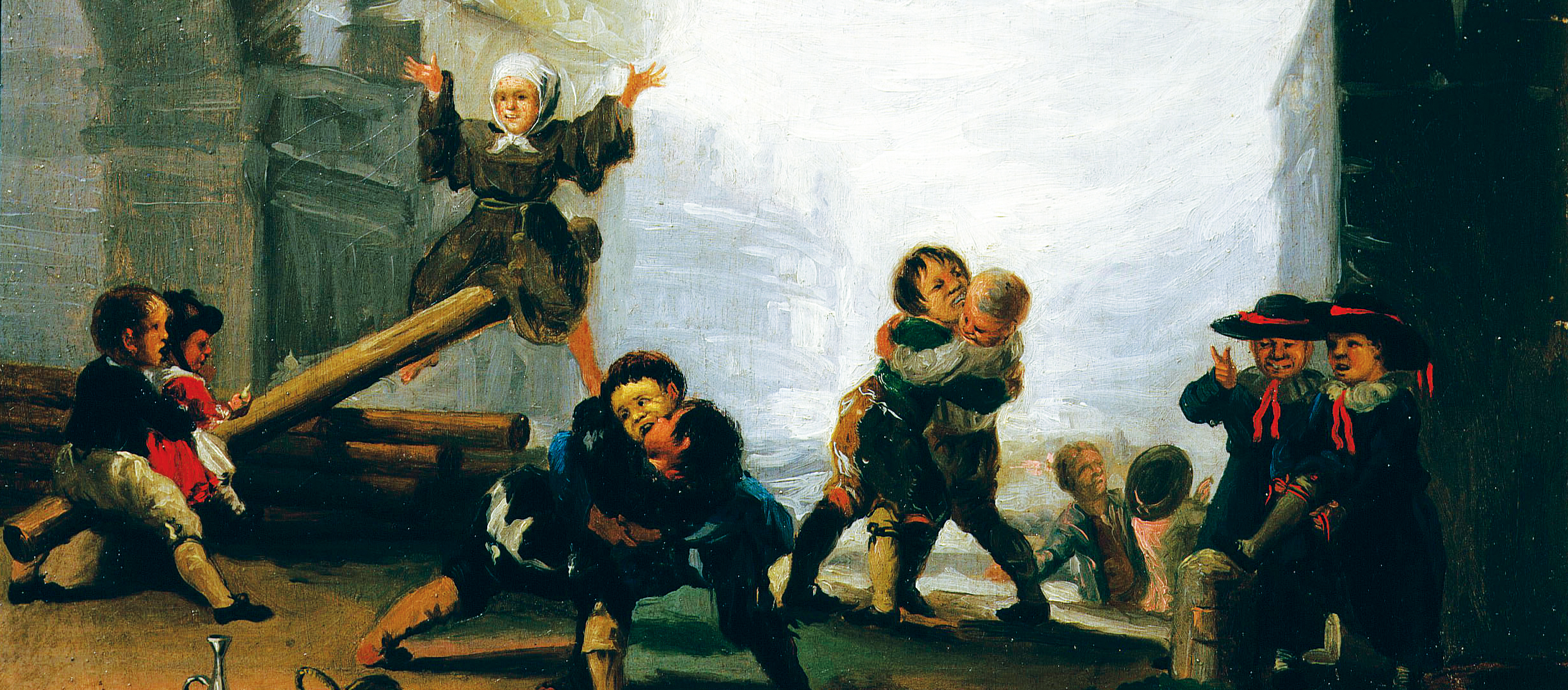
Boys Playing at Seesaw, attributed to Francisco José de Goya y Lucientes, c. 1785. National Museum, Gdańsk, Poland.
In the world of the Glass Bead Game, new works of art and pure science have long since ceased to appear; the persons from whose labors its symbol sets are derived all lie in the past, and their purified achievements alone remain, reduced (or elevated) to generalized spiritual or intellectual impulses. Maybe in the realm of sport we are entering into a period when, like Hesse’s contemplatives, committed devotees will peaceably meditate upon and combine the essences of activities they no longer dream of doing. In the dim confines of the sports bar, surrounded by a dozen screens the size of Gobelin tapestries, the mental player will comprehend a dozen contests playing out around the world, while sophisticated algorithms produce endless sidebar comparisons and projections for him. In the world he observes, fans rage or exult, but he is still. He can neither win nor lose (the games; he can lose his bets). He comes to experience the pathos and wonder of all games, the game that is the universe.
No. No matter how rarefied and abstracted such a game of games could become, no matter how removed the players of it, it would still be infused with competition and meaningless without it; such a game could not comprehend a sport without winners, or the striving to win. At the heart of it would always be not glass beads or bare ideas but humans, expending concentrated physical effort over the course of a contest or a career to beat the others: succeeding against odds, failing heroically against odds, swerving comically off track, returning in triumph, doggedly persisting, extraordinary yes, exemplary maybe, but always actual and living. Statistics seem to show that committed players of fantasy football tend to increase their watching of the armored, heraldic, sometimes tragically wounded titans on TV.
We cannot say what the woman might be physically, if the girl were not allowed all the freedom of the boy in romping, climbing, swimming, playing whoop and ball.
—Elizabeth Cady Stanton, 1848It’s perhaps worth noting that the Glass Bead Game, and the love and devotion to it, are as exclusively the province of males as is the NFL. But Hesse’s game players are not in competition with one another (as I have belatedly learned) and all sense of striving is absent from the game itself. The still spirits of Castalia might have condoned a little healthful exercise, but they could not have even entertained the notion of deep engagement with potent representations of sport, the meaningless realm of striving for striving’s sake.
And yet those crystallized works of perfect art, whose essences they sip—how after all did they come to be, in what forge were they at first produced? The future is uninterested in biography. “We have no idea whether Johann Sebastian Bach or
Wolfgang Amadeus Mozart actually lived in a cheerful or despondent manner,” says the book’s narrator. “Mozart moves us with that peculiarly touching and endearing grace of early blossoming and fading; Bach stands for the edifying and comforting submission to God’s paternal plan of which suffering and dying form a part.”
But of course all those beatified artists, even the great philosophers and mathematicians, though they lived to make and to think, actually lived in the world, often in restless and warring ages. They competed for patronage or academic success or public approval, outdid their rivals or were outdone by them, were wounded and recovered or did not, and struggled to win renown and get money and love by means of their skill at and devotion to their art: and what they achieved was always shaped and often compromised by that struggle. Others lost or gave up, and they and their works are swallowed in oblivion, not always justly. Surely Hesse knew all that.
A fight for love and glory, as Dooley Wilson at the piano in Casablanca told us: it’s still the same old story. If we aren’t competing toe to toe with the opposing team or eye to eye with our friends and neighbors, we are competing for space in the columbarium with the great dead. After decades of freelancing, I went to work in the academy, which doesn’t resemble a tower or anything at all made of ivory; newly arrived there, I was asked by a student reporter the common question Why do you write? And the answer that came out of my mouth, all unbidden and somewhat alarming to me to hear, was that I write in order to win immortal fame. I don’t like my chances. It’s never been a zero-sum game, though, even if it is a game played for keeps; the winners are few, but the losers are playing too, and the score isn’t fixed.
